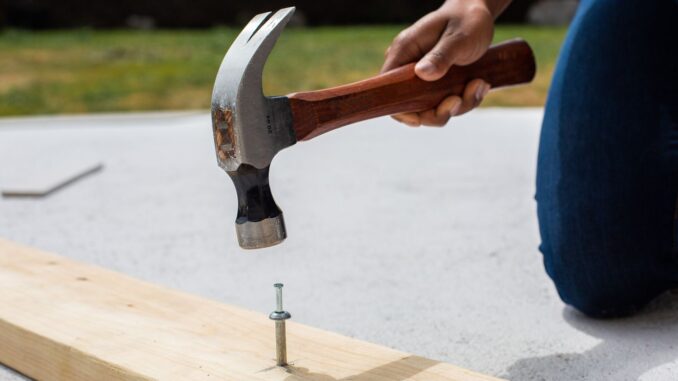
Attach wood to concrete without drilling can seem like a complicated task. Concrete is a strong, durable material often used in floors, walls, and foundations. Drilling into it is typically the go-to method when you want to secure another material. But what happens if you want to avoid drilling? There are many situations where drilling isn’t an option, such as preserving the concrete surface, avoiding permanent damage, or creating temporary setups.
This article will guide you through several methods to attach wood to concrete without drilling. Whether you’re working on a temporary installation or simply want to avoid holes in your concrete, you’ll find a solution that works for your needs. We’ll provide detailed steps for each method, along with tips for preparing both the wood and concrete surfaces for the best results. So, let’s dive in!
Why Choose to Attach Wood to Concrete Without Drilling?
There are many reasons why someone would prefer to attach wood to concrete without drilling holes. Let’s explore why this approach is not just practical but often preferable in many scenarios.
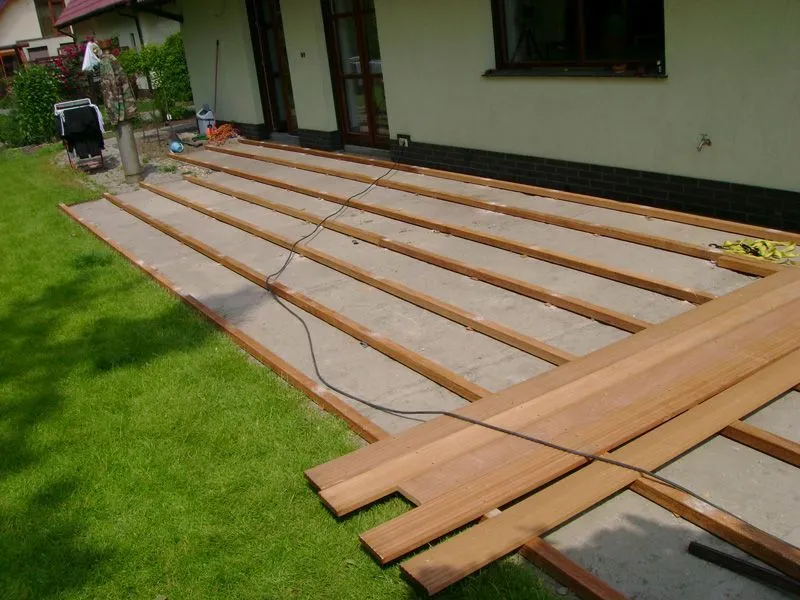
Avoiding Permanent Damage
Drilling into concrete can cause permanent damage to the surface. Holes are left behind, and over time, this can weaken the concrete. This is especially problematic if the concrete is part of a structural element, like a foundation or floor slab. For anyone concerned about the integrity of their concrete surface, avoiding drilling is crucial.
By using adhesive-based methods or mechanical solutions that don’t require drilling, you can safely attach wood to concrete without risking any long-term damage to your surface. This is a huge advantage when working in spaces where the concrete needs to remain intact for future modifications.
Temporary Setups
Another common reason to attach wood to concrete without drilling is the need for temporary installations. Whether you’re creating a temporary partition, a display stand, or even a short-term shelving unit, drilling may not be the best solution. Drilling can cause unnecessary damage, and temporary setups might not justify the effort and time required to drill into concrete.
Using alternatives such as adhesives or Velcro strips allows for a quick setup that can be removed just as easily. Once the setup is no longer needed, you can simply dismantle it without leaving behind any holes or marks.
Preserving the Concrete’s Look
Concrete surfaces, especially polished or decorative ones, can be visually appealing. Drilling holes can detract from the aesthetics, leaving unsightly marks or requiring costly repairs. If you’re working in a space like a showroom, gallery, or even your home, you’ll want to preserve the clean look of the concrete.
Using non-invasive methods to secure wood to concrete without drilling ensures that your surface stays pristine and the final result is visually pleasing. This approach is ideal for anyone who values the look and feel of their concrete surfaces.
Reducing Noise and Vibration
Drilling concrete can create significant noise and vibration, which might be disruptive, particularly in apartment buildings or shared spaces. The sound of the drill can be loud, and vibrations could travel through the walls or floor, disturbing those around you.
If you need to mount wood on concrete without drilling, using methods such as construction adhesives or double-sided mounting tape can eliminate noise and vibration entirely. These quiet techniques provide a hassle-free and peaceful experience during installation.
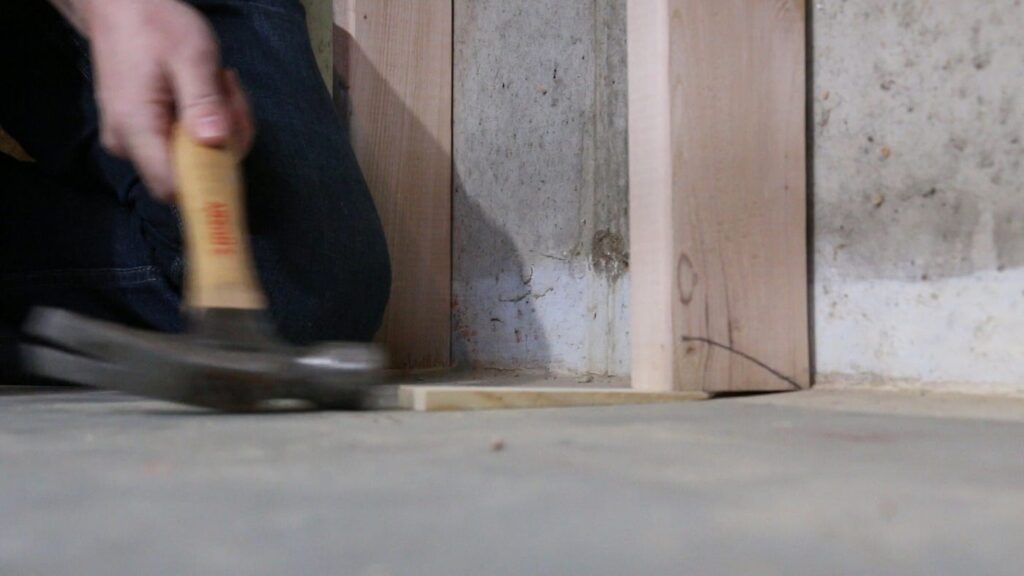
Methods for Attaching Wood to Concrete Without Drilling
There are multiple methods available to attach wood to concrete without drilling. Each technique comes with its own set of advantages, depending on the size and nature of the project. Let’s dive into the various options, step by step.
1. Using Construction Adhesive
Construction adhesive is one of the most reliable ways to attach wood to concrete without the need for drilling. This method is highly versatile and provides a solid bond between the wood and concrete.
How it Works:
Construction adhesive is formulated to bond materials such as wood, concrete, metal, and stone. The adhesive creates a strong bond without needing nails, screws, or other fasteners. Once applied to the wood and pressed against the concrete, the adhesive dries and hardens, ensuring a durable connection.
Benefits:
- No Drilling: No need to create holes in the concrete.
- Clean Look: It leaves no visible fasteners, keeping your installation clean and seamless.
- Versatile: Suitable for both light-duty and heavy-duty applications.
- Strong Bond: Provides a long-lasting, secure attachment.
Instructions:
- Clean the Surfaces: Begin by cleaning both the concrete and wood surfaces. Remove any dust, dirt, grease, or other contaminants that might interfere with the bond.
- Apply the Adhesive: Spread the construction adhesive evenly on the wood’s surface. It’s a good idea to apply it in thin, consistent layers.
- Press and Hold: Press the wood against the concrete and hold it in place for a few minutes to ensure a good bond.
- Allow to Cure: Let the adhesive cure for 24 hours to achieve the strongest bond.
Tips for Success:
- Surface Preparation: Make sure both the wood and concrete are dry before applying the adhesive. Wet surfaces will weaken the bond.
- Even Application: Apply the adhesive in small beads or zigzag patterns to cover the entire surface area.
- Clamping: If possible, use a clamp or heavy object to keep the wood in place while the adhesive cures.
2. Using Double-Sided Mounting Tape
For lighter applications, double-sided mounting tape can be an effective alternative for securing wood to concrete without drilling. Mounting tape is a quick, simple solution for attaching small or lightweight wood pieces to concrete.
How it Works:
Mounting tape has adhesive on both sides and provides an instant bond when pressed against the surfaces. This makes it an ideal choice for decorative or temporary wood attachments.
Benefits:
- No Drilling: No need for screws, nails, or drills.
- Temporary: Perfect for setups that need to be changed or removed easily.
- No Mess: Easy to apply without any mess, making it a clean solution.
Instructions:
- Prepare Surfaces: Ensure both the concrete and wood are clean and dry.
- Apply Tape: Cut the double-sided tape to fit the size of the wood and press it firmly onto the back of the wood.
- Attach Wood: Press the wood against the concrete surface and hold it in place for a few seconds to ensure good adhesion.
- Press Firmly: Apply more pressure if necessary to ensure the tape sticks.
Considerations:
This method is best suited for lightweight projects. It is not recommended for heavy-duty applications where strength and durability are required.
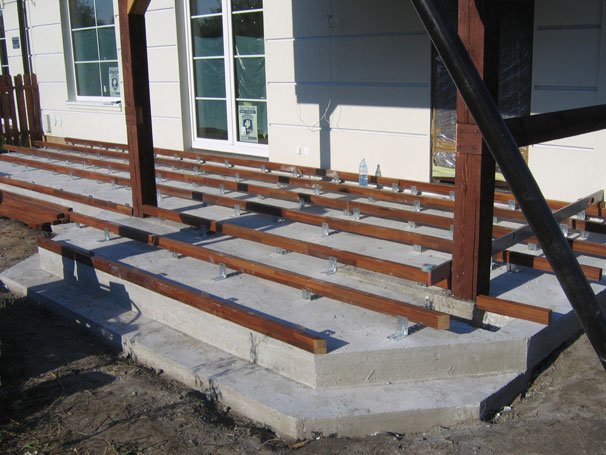
3. Using Epoxy Resin for Bonding
Epoxy resin is another powerful adhesive for bonding wood to concrete without using drills. Epoxy is a two-part resin that, when mixed together, creates an incredibly strong bond.
How it Works:
Epoxy resin works by chemically bonding to the concrete and wood. It’s especially effective for heavy-duty projects or situations where you need a permanent attachment.
Benefits:
- Extremely Strong Bond: Ideal for heavy-duty applications.
- Durability: Provides a permanent, waterproof bond.
- Ideal for Rough Surfaces: Works well on both rough and smooth concrete.
Instructions:
- Mix Epoxy: Follow the manufacturer’s instructions to mix the two parts of the epoxy resin. Make sure to mix thoroughly to activate the bonding process.
- Apply Epoxy: Spread the epoxy evenly on the back of the wood.
- Attach the Wood: Press the wood firmly against the concrete surface. Ensure that there is even pressure across the entire surface.
- Curing Time: Let the epoxy cure for 24 hours or as instructed by the manufacturer.
Tips for Best Results:
- Surface Preparation: Sand both the concrete and wood surfaces before applying epoxy for the best bond.
- Ventilation: Work in a well-ventilated area, as epoxy can produce fumes during application.
- Weight: Use clamps or heavy objects to keep the wood in place while the epoxy sets.
4. Using Liquid Nails or Other Strong Adhesives
Liquid Nails and similar adhesives are another excellent option for securing wood to concrete without drilling. These adhesives are specifically formulated for heavy-duty applications, offering a reliable bond that can hold substantial weight.
How it Works:
Liquid Nails provides a strong adhesive bond by filling the gaps between the wood and concrete. Once it cures, it creates a durable, secure attachment.
Benefits:
- Strong and Durable: Liquid Nails can hold large pieces of wood.
- No Mess: Clean application without any drilling or hammering.
- Quick to Use: It’s simple to apply and doesn’t require a lot of effort.
Instructions:
- Clean the Surfaces: Ensure both the wood and concrete are free from dirt and oils.
- Apply Liquid Nails: Apply the adhesive to the wood in a thin, even layer.
- Press and Hold: Press the wood against the concrete and hold it in place for several minutes to form a solid bond.
- Allow to Dry: Let the adhesive set for at least 24 hours for the best results.
Tips:
- Even Application: Spread the adhesive evenly to avoid any gaps.
- Clamping: Use clamps to hold the wood in place while the adhesive dries.
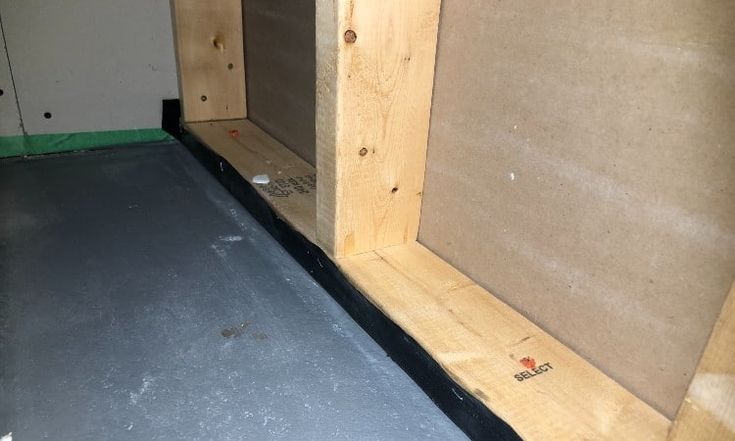
5. Using Wood Blocks or Furring Strips (No Drill, No Adhesive)
Another way to attach wood to concrete without drilling holes is by using wood blocks or furring strips as a base. This method avoids adhesives and drilling altogether, using mechanical means to secure the wood to the concrete.
How it Works:
Furring strips or wood blocks are glued or taped to the concrete. Then, the wood can be attached to these blocks using nails or screws, avoiding drilling directly into the concrete.
Benefits:
- Non-permanent: Can be removed or reinstalled without damaging the concrete.
- Supports Heavy Wood: Suitable for heavier pieces of wood that need extra support.
Instructions:
- Prepare the Surface: Clean the concrete thoroughly.
- Apply Blocks or Furring Strips: Attach the wood blocks or furring strips to the concrete using adhesive or mounting tape.
- Attach the Wood: Secure the wood to the blocks using screws or nails, not penetrating the concrete.
Considerations:
- Weight Considerations: Make sure the wood blocks or strips are sufficiently strong to hold the weight of the wood.
- Temporary: This method is perfect for temporary setups but can also be adapted for more permanent installations if needed.
6. Using Velcro Strips or Hook-and-Loop Tape
For lightweight or temporary installations, Velcro strips or hook-and-loop tape provide a fast and easy solution for attaching wood to concrete without drilling. These materials offer the flexibility to remove the wood and reattach it as needed, making them ideal for non-permanent setups.
How it Works:
Velcro strips have a peel-and-stick adhesive backing, which allows them to be applied to both wood and concrete surfaces. The hook-and-loop system lets you easily attach and detach the wood when needed. This makes it an excellent choice for decorative projects, small displays, or lightweight shelving.
Benefits:
- Quick Installation: Simple to apply with no mess or complex tools.
- Temporary Solutions: Ideal for applications that require removal or repositioning.
- Clean Removal: The adhesive backing can be removed without leaving permanent marks or residue on the concrete.
Instructions:
- Clean the Surfaces: As with any adhesive method, start by cleaning both the wood and concrete surfaces.
- Apply the Velcro: Stick one side of the Velcro to the back of the wood and the other to the concrete surface.
- Press Firmly: Press the two surfaces together to ensure a secure bond.
- Adjust as Needed: The Velcro allows you to detach the wood from the concrete and reattach it with ease if adjustments are necessary.
Considerations:
- Limited Strength: Velcro strips are best suited for lighter wood pieces and temporary uses.
- Not for Heavy Loads: For heavier wood, this method may not provide enough holding power, and a more robust method should be considered.
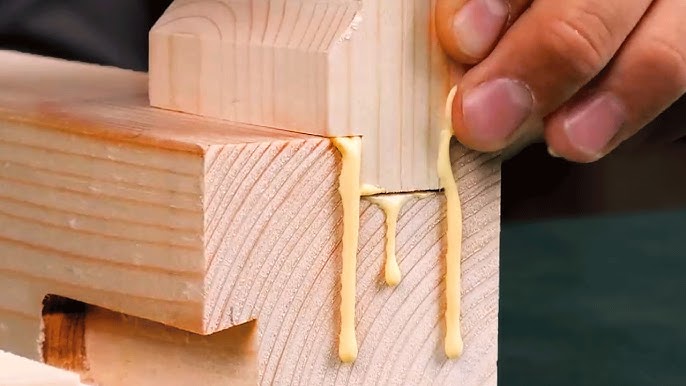
7. Using Interlocking Flooring Systems
Interlocking flooring systems, such as modular tiles or panels, offer another way to mount wood on concrete without drilling. These systems create a base for attaching wood pieces without having to directly drill into the concrete.
How it Works:
Interlocking floor tiles or panels snap together and create a stable surface on top of the concrete. Once in place, you can secure the wood to the tiles using adhesive, screws, or even Velcro strips, depending on the project’s requirements.
Benefits:
- No Permanent Drilling: The interlocking panels rest on top of the concrete without causing any damage.
- Flexibility: These systems can be rearranged or removed, allowing for temporary setups.
- Strength and Stability: Once interlocked, the flooring provides a solid base to support heavier wood pieces.
Instructions:
- Lay the Tiles: Arrange the interlocking tiles or panels on the concrete surface.
- Secure the Wood: Use adhesive or screws to attach the wood to the top of the tiles. The interlocking design adds stability and support.
- Adjustable Setup: If needed, you can easily adjust the layout of the interlocking tiles without damaging the concrete.
Considerations:
- Floor Space: Interlocking systems work best for larger installations or projects where flexibility is important.
- Temporary Projects: This method is ideal for temporary setups like flooring or outdoor structures, but may not be practical for small-scale or single-piece applications.
8. Using Magnets for Small or Temporary Attachments
For small wood pieces or lightweight projects, using magnets to attach wood to concrete without drilling can be an innovative and easy solution. This method is particularly effective for lightweight decor, small wooden panels, or temporary signs.
How it Works:
Strong magnets are attached to both the wood and concrete, creating a bond that allows you to easily attach and remove the wood without drilling. This is particularly useful for projects where the wood needs to be frequently repositioned or removed.
Benefits:
- No Drilling or Adhesives: This is a non-invasive solution that leaves no residue or damage to the surfaces.
- Temporary: Magnets allow for easy detachment, perfect for projects that need to be moved or changed often.
- Customizable: You can use as many magnets as necessary to achieve the desired strength and hold.
Instructions:
- Choose Strong Magnets: Select magnets that are strong enough to support the weight of the wood.
- Attach Magnets to Wood: Secure the magnets to the back of the wood using adhesive or small screws.
- Place Magnets on Concrete: Attach the corresponding magnets to the concrete surface. Ensure that the magnets align properly with the ones on the wood.
- Mount the Wood: Press the wood onto the concrete, letting the magnets snap into place.
Considerations:
- Weight Limitations: Magnets work best for light-to-medium weight wood. Larger or heavier wood pieces may require additional support.
- Precision: This method requires precise alignment of the magnets to ensure a strong hold.
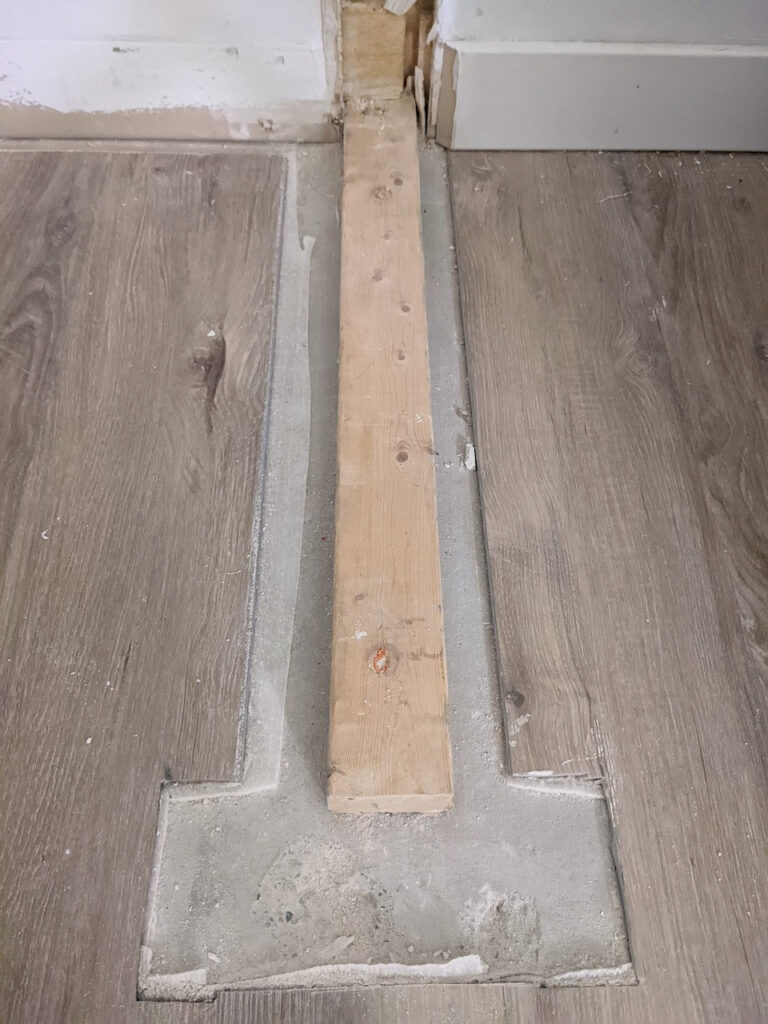
9. Using Pressure and Clamps
If you only need to temporarily attach wood to concrete without drilling, using clamps or pressure-based tools can be a viable solution. This approach is often used for projects like temporary barriers, wood frames, or temporary shelving.
How it Works:
Pressure is applied to hold the wood in place against the concrete surface. Clamps, suction cups, or other pressure-based tools help secure the wood without causing any damage to the concrete or the wood.
Benefits:
- Quick and Easy: Setting up with clamps or pressure tools takes only a few minutes.
- No Permanent Attachment: Ideal for temporary projects or when you need to adjust the setup frequently.
- No Drilling: This method avoids drilling or using adhesives.
Instructions:
- Position the Wood: Place the wood where you want it on the concrete surface.
- Use Clamps or Pressure Tools: Apply pressure using clamps, suction cups, or other tools to hold the wood securely.
- Allow Adjustment: Since there is no permanent attachment, you can move or remove the wood as needed.
Considerations:
- Temporary Use: This method is best for short-term applications and may not provide the stability needed for long-term installations.
- Tool Availability: Depending on the size of the project, you may need several clamps or suction cups to hold the wood securely.
Preparing Concrete and Wood Surfaces for Attachment
The success of any method for attaching wood to concrete without drilling depends on the preparation of both surfaces. Proper cleaning and priming ensure that the bond is strong and lasts as long as necessary.
Cleaning the Concrete Surface
Before applying adhesives, tapes, or magnets, make sure the concrete surface is free from dirt, dust, grease, and other contaminants. These substances can interfere with the bonding process and result in a weak or unstable attachment.
Use a vacuum or a broom to remove dust and dirt. Then, clean the surface with a damp cloth or mild cleaning solution to remove oils and grime. Allow the concrete to dry completely before proceeding with any attachment method.
Preparing the Wood Surface
Likewise, the wood should be clean and smooth to achieve the best results. Sand down any rough patches, as these can prevent adhesives from sticking properly. If the wood has been painted or treated, make sure it is fully dry and not peeling before attaching it to the concrete.
If you’re using a construction adhesive, you may want to lightly roughen the wood surface with sandpaper to improve the bond. For some methods, like using double-sided tape, the smoother the wood surface, the better the adhesion.
Temperature and Humidity Considerations
Temperature and humidity can affect the strength of adhesives and other bonding materials. Ensure that the room temperature is within the recommended range for the adhesive you are using. Avoid applying adhesives or pressure-based methods in excessively humid or cold environments, as this can prevent the materials from bonding properly.
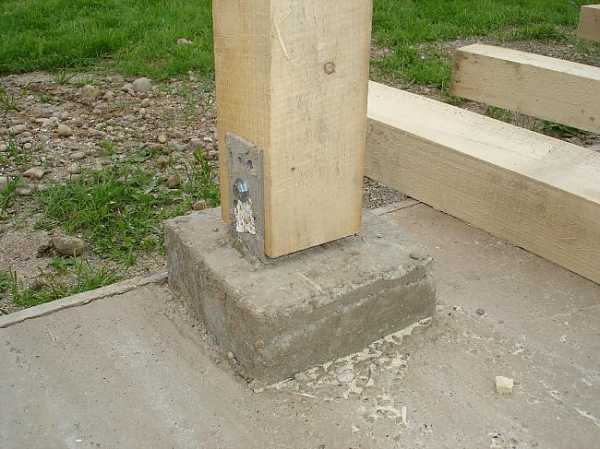
Safety Tips and Best Practices
When working with adhesives, clamps, or any bonding agents, safety should be a priority. Here are some tips to ensure you work safely while attaching wood to concrete without drilling:
Wear Protective Gear
Always wear gloves and safety glasses when working with adhesives, resins, or other chemicals. Some bonding agents, like epoxy and certain adhesives, can be irritating to the skin or eyes.
Ensure Proper Ventilation
Many adhesives and resins release fumes that can be harmful if inhaled. Always work in a well-ventilated area, or use a fan to ensure proper airflow.
Follow Manufacturer Instructions
Each adhesive, resin, or other bonding material will have specific instructions for application, curing times, and safety. Make sure to follow these guidelines carefully to ensure the best results.
Troubleshooting Common Issues
Even with the best techniques, sometimes the bond doesn’t work as expected. Here are a few common problems and their solutions when you attach wood to concrete without drilling:
Bond Not Holding
If the adhesive isn’t holding the wood securely, check the following:
- Ensure both surfaces are clean and dry.
- Use a stronger adhesive or resin for heavier wood.
- Make sure the bond has cured for the recommended time.
Lifting or Peeling
If the adhesive begins to peel off the concrete or wood, the surface may not have been prepared properly. Sanding the surfaces lightly can help improve adhesion. Also, ensure the adhesive was applied evenly and the materials were pressed together firmly.
Misalignment
If the wood is not aligning correctly with the concrete, try repositioning it while the adhesive is still wet. For pressure-based methods, use clamps or magnets to hold the wood in the correct position while the bond sets.
Creative and Practical Uses for Attaching Wood to Concrete Without Drilling
There are many creative and practical applications for attaching wood to concrete without drilling. Some common uses include:
Home Decor Projects
You can create beautiful floating shelves, decorative wall panels, or other wall-mounted wood elements without damaging your concrete walls. This method is also perfect for hanging art pieces, photo frames, and more.
Temporary Installations
For pop-up shops, exhibitions, or temporary offices, you can install wooden partitions, shelving units, or display stands without drilling into the concrete floor or walls. This is ideal for creating a flexible setup that can be quickly removed and relocated.
Workshops and Garages
In workshops or garages, you can create custom workbenches, tool organizers, or shelving units by attaching wood to concrete surfaces using adhesives or mounting strips. This is an efficient way to maximize space without the need for permanent alterations.
Outdoor Projects
If you’re working on outdoor structures, such as a garden shed or temporary fencing, attaching wood to concrete without drilling offers flexibility. You can attach wooden panels or decorative elements to concrete surfaces without damaging them. This method works well for outdoor installations that may need to be moved or reconfigured over time.
Retail Displays
Retailers can use these methods to attach wooden shelving or signage to concrete walls without drilling holes, ensuring the wall remains intact. Whether for temporary sales setups or permanent installations, attaching wood to concrete without drilling allows for easy changes and updates to the display layout.
Wrapping Up: Finding the Best Method for Your Project
When you want to attach wood to concrete without drilling, you have many options to choose from. The right method depends on your specific needs — whether you need something temporary or permanent, light or heavy-duty, or an easily adjustable solution. Whether you choose adhesives, pressure-based methods, or magnetic systems, it’s important to consider both the wood and concrete surfaces’ condition to achieve the best bond.
By following the guidelines and safety tips outlined above, you’ll be able to successfully secure wood to concrete without drilling, making your project both simple and effective. Each method has its own advantages and applications, so selecting the one that works best for you is key to ensuring that your project is both functional and visually appealing.
Frequently Asked Questions (FAQs)
How strong are adhesive bonds compared to drilled holes?
Adhesive bonds can be as strong as drilled holes, but it depends on the materials and adhesives used. For lighter wood and concrete, adhesive methods can be very strong. For heavy-duty applications, using a strong construction adhesive or epoxy resin can ensure a solid hold.
Can I remove wood attached with adhesive without damaging the concrete?
Yes, most adhesives allow for removal without damaging the concrete, but it depends on the type of adhesive used. Gentle adhesives, like mounting tape, can be removed cleanly, while stronger adhesives may leave residue that can be cleaned off with a solvent.
What is the best adhesive for attaching wood to wet or damp concrete?
For wet or damp concrete, you should use a moisture-resistant adhesive like epoxy resin or a heavy-duty construction adhesive designed for wet conditions. Always ensure the concrete is not too wet, as this can affect the bond.
How do I ensure the bond lasts over time without drilling?
To ensure a lasting bond, make sure to properly clean and prepare both the wood and concrete surfaces. Additionally, choose the right adhesive for the materials you’re working with and allow the bond to cure fully before using the attached wood. Environmental factors, like temperature and humidity, should also be considered when choosing the right adhesive.
Final Thoughts
Attaching wood to concrete without drilling is a practical solution for many DIY projects, renovations, and temporary setups. From adhesives and pressure methods to magnetic systems and Velcro strips, there are multiple ways to secure wood to concrete surfaces without the need for drilling.
The benefits of avoiding drilling are clear: no damage to the concrete, easier removal, and flexibility for changing setups. By understanding the different methods and considering the specific requirements of your project, you can choose the best approach to achieve a strong and reliable bond between wood and concrete. Whether you are looking for a temporary or permanent solution, these techniques can help you complete your project successfully while keeping your surfaces intact.
Give these methods a try, and enjoy the versatility and convenience of attaching wood to concrete without drilling!